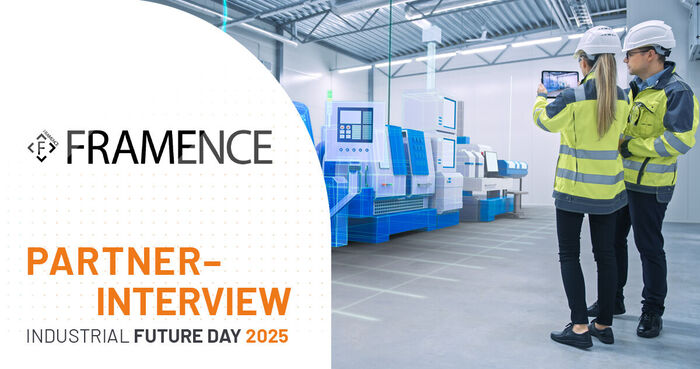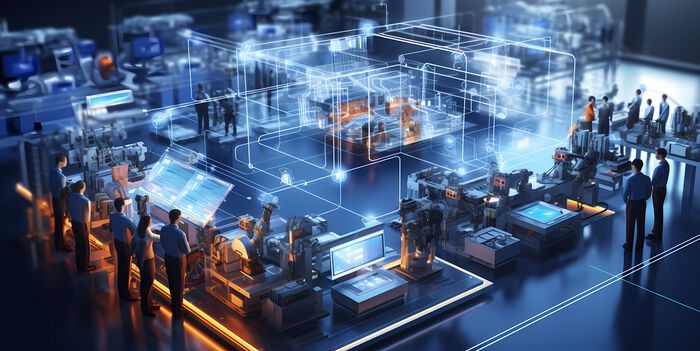
Adrian Merkel is the Managing Director of Framence in Bensheim. The company's digital platform enables businesses to create a highly accurate virtual representation of their shop floor, helping to increase productivity, drive sales, and enhance security.
Mr. Merkel, the INDUSTRIAL FUTURE DAY focuses on solutions that drive digitalization, efficiency, and sustainability in businesses. Which industries do you serve, and how do you support your customers?
Adrian Merkel: We have been developing software for nearly 40 years, primarily for building and facility operators. We started with 3D design and architectural software before shifting our focus to operational processes. Today, we support companies in all aspects of managing and operating building and facility portfolios.
In recent years, we have noticed that customers are increasingly struggling with the documentation of their facilities. The shop floor evolves with every new installation, with constant modifications and upgrades. Often, there is no accurate documentation available, and critical information such as machine types, cable layouts, or the location of key infrastructure is missing. This poses a real challenge—engineers can spend up to 30% of their working time searching for such information.
With Framence, we apply the Google Street View concept to the factory. The platform allows users to navigate through a photorealistic representation of the shop floor as if they were physically on-site. However, a digital twin is only effective if it can be easily and cost-effectively updated. That’s why our approach differs from traditional 3D modeling solutions or platforms like Nvidia Metaverse. We rely on simple camera technologies, such as DSLR or smartphone cameras, to capture facilities and their surroundings instantly, enabling a fast rollout.
Any asset can be enriched with plans and data, for example, from ERP systems. The use of AI unlocks even more possibilities—we can recognize photos, names, barcodes, and QR codes, collect information, and link it to the model. With this virtual representation of the factory, customers save significant time and can allocate skilled workers more efficiently. This benefits various levels of the company—from maintenance teams to plant managers and even executives who want real-time insights into their factories in China or anywhere else in the world.
Could you share some concrete examples of use cases and results?
AM: One of our customers, a chemical company, built a plant in the U.S. two years ago. During the construction phase, up to ten employees had to fly to the site every month to monitor and document progress—a massive logistical effort. We equipped the on-site construction managers with cameras, allowing them to document every change. These data were then fed into the digital model, enabling the customer to remotely oversee the entire construction progress. Additionally, specialized processes such as facility planning and material storage were integrated into the model. As a result, the company was able to replace almost all travel with video meetings. Now, only the executive board occasionally travels to the U.S. in person.
Another customer operates multiple plants in Eastern Europe, where employee turnover is typically very high, making efficient onboarding particularly important. With Framence, new employees no longer need to be physically guided through production, which would otherwise disrupt operations. Instead, they can prepare for their role remotely—either from home or the back office. They can virtually explore the facilities, study details, and access additional videos and information. After completing a test, they can start working immediately. This significantly accelerated the onboarding process, and the customer now requires far fewer resources to train new employees.
"Purely virtual, idealized models are only partially suitable for this purpose, as the factory has often already evolved in reality."

Which current developments regarding the industrial future should companies keep an eye on?
AM: A current topic is robotics, especially the rapid advancements in humanoid robots. For these robots to reliably perform their tasks in the future and effectively assist in hazardous situations, they need to be familiarized with their environment and trained accordingly.
Purely virtual, idealized models are only partially suitable for this purpose, as factories often evolve beyond their initial digital representations. In contrast, models like ours, which accurately reflect real production conditions, are highly effective for training robots.
Please give us a brief preview of your presentation at INDUSTRIAL FUTURE DAY 2025. What can participants look forward to?
AM: In my presentation, I will briefly introduce our approach to creating digital twins and our technology. I will then highlight some exciting customer case studies, explaining the specific benefits in terms of process optimization, operations, and maintenance. Additionally, I will discuss advantages related to safety, auditing, and risk management.
REGISTER NOW FOR THE INDUSTRIAL FUTURE DAY 2025
Learn from Adrian Merkel at our event how to create a realistic virtual representation of the shop floor.
LEARN MORE AND REGISTER
(EVENT IN GERMAN LANGUAGE)